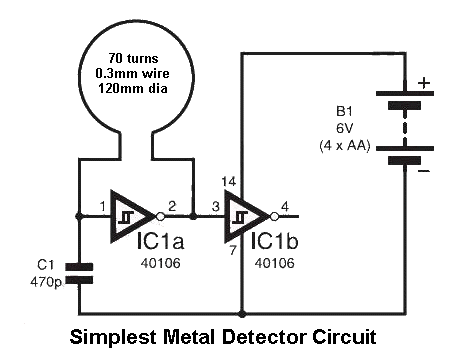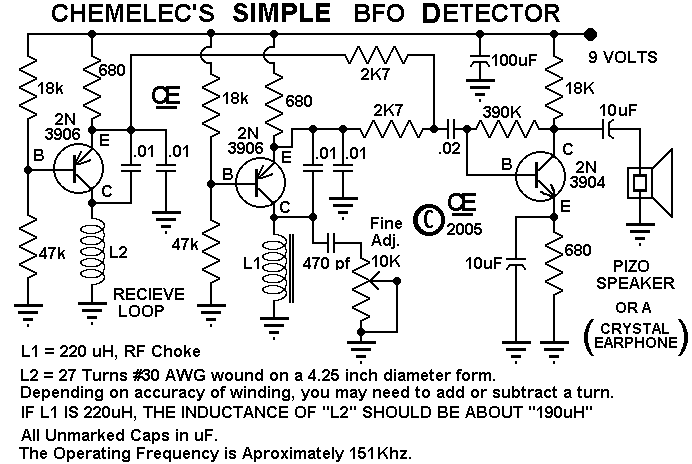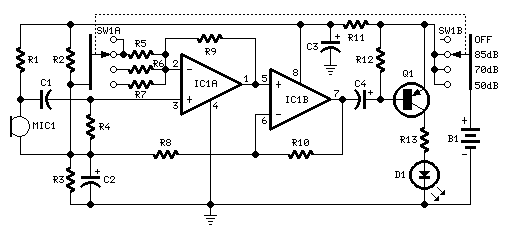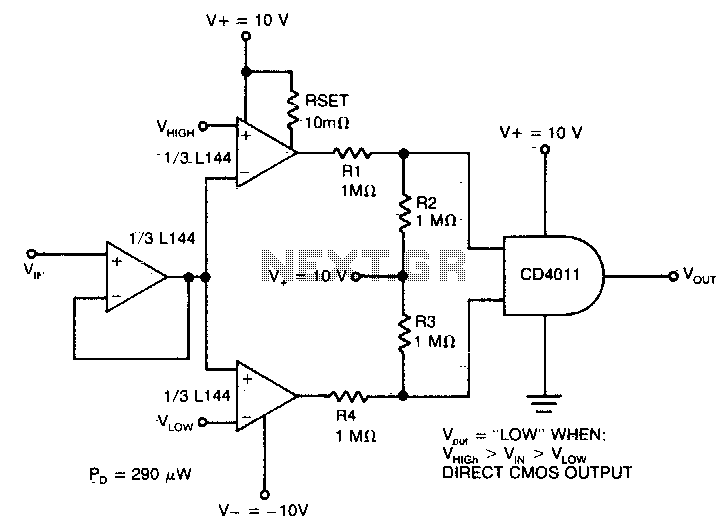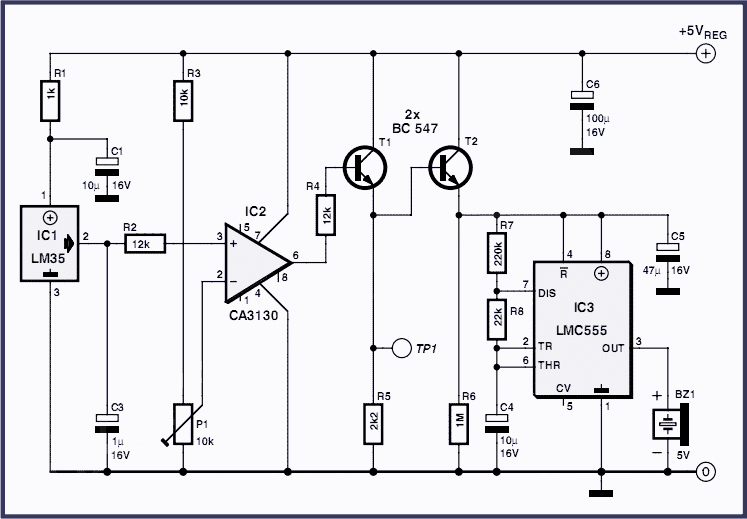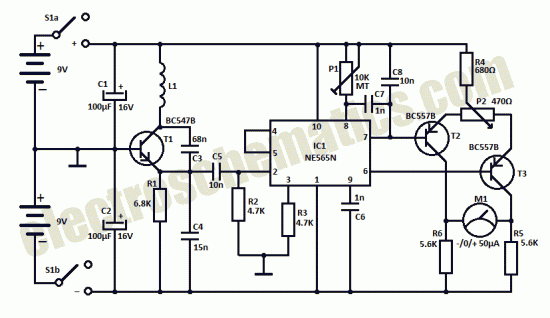
Metal detector 7

The metal detector circuit employs an LC single-tube oscillator configuration, as illustrated in Figure 8-73. In this circuit, V represents the oscillating tube, L denotes the detection coil, and C1 is the resonant capacitor. Upon activation of the power switch S, the LC single-tube oscillator circuit initiates oscillation, causing the semiconductor superheterodyne radio speaker to emit sounds at a frequency of 1 kHz. When the search coil L identifies underground metal, the radio frequency of the speaker's sound increases. The resistor R is a variable resistor (270Ω) connected in series; capacitors C2 and C3 are high-frequency ceramic or glaze capacitors. The transistor V can be a 3AGl or 3AGIl High Frequency Low Power PNP germanium transistor. The power supply GB consists of a 9V laminated battery. The coil L is constructed from enameled wire with a diameter of 0.5 mm, wound around a magnet bar measuring 5 mm x 10 mm x 80 mm with 80 turns (60 turns at the tap, W1 has 60 turns, and W2 has 20 turns). To enhance the sensitivity of the coil L, it is recommended to wind the coil with a diameter of 30 cm, ensuring that the coil remains parallel to the ground.
The metal detector circuit functions based on the principles of oscillation and resonance within an LC circuit. The oscillating tube (V) generates a high-frequency signal, which is modulated by the presence of metal objects in proximity to the detection coil (L). The detection coil is a critical component, as it is responsible for sensing changes in the electromagnetic field caused by metallic objects.
The resonant capacitor (C1) works in conjunction with the inductance of the coil (L) to establish a resonant frequency, which is tuned to the desired operating frequency of the circuit. The variable resistor (R) allows for fine-tuning of the circuit's sensitivity, enabling the user to adjust the detection threshold based on environmental conditions.
The choice of capacitors (C2 and C3) is essential for maintaining the stability and performance of the circuit at high frequencies. High-frequency ceramic or glaze capacitors are preferred due to their low equivalent series resistance (ESR) and excellent frequency response characteristics.
The PNP germanium transistor (V) serves as an amplifier, boosting the signal generated by the oscillating tube to drive the speaker. The 9V laminated battery (GB) provides the necessary power supply for the entire circuit, ensuring reliable operation.
The construction of the coil (L) is also vital for the performance of the metal detector. The specific dimensions and number of turns are designed to optimize the inductance and sensitivity of the coil. By increasing the diameter of the coil to 30 cm, the detection range can be enhanced, allowing for the detection of larger or deeper metal objects. The recommendation to keep the coil parallel to the ground is crucial for achieving optimal performance and sensitivity during operation.
Overall, this metal detector circuit offers a practical application of basic electronic principles, combining oscillation, resonance, and amplification to detect metallic objects buried underground.That metal detector circuit uses LC single-tube oscillator circuit, it is shown as Figure 8-73. In the circuit, V is oscillating tube, L is the detection coil, Cl is the resonant capacitor. After turning on power switch S, the LC single-tube oscillator circuit starts oscillation, semiconductor superheterodyne radio speaker will issue the sounds with the frequency in lkHz. When the search coil L detects underground metal, the radio frequency of the sound of the speaker becomes high. Component`s selection R uses variable resistor (270P seal simply connected); C2 and C3 use high frequency ceramic capacitor or glaze capacitors.
V selects 3AGl or 3AGIl High Frequency Low Power PNP germanium transistors. GB uses 9V laminated battery. L uses enameled wire with †O · 5lmm which is winded on the 5mmxlOmmx8Omm magnet bar with 80 turns (60 turns at the tap, W1 has 60 turns, W2 has 20 turns. ) For increasing the sensitivity of L, it can also be winded the coil with the diameter in 3Ocm, the coil should be parallel to the ground.
🔗 External reference
The metal detector circuit functions based on the principles of oscillation and resonance within an LC circuit. The oscillating tube (V) generates a high-frequency signal, which is modulated by the presence of metal objects in proximity to the detection coil (L). The detection coil is a critical component, as it is responsible for sensing changes in the electromagnetic field caused by metallic objects.
The resonant capacitor (C1) works in conjunction with the inductance of the coil (L) to establish a resonant frequency, which is tuned to the desired operating frequency of the circuit. The variable resistor (R) allows for fine-tuning of the circuit's sensitivity, enabling the user to adjust the detection threshold based on environmental conditions.
The choice of capacitors (C2 and C3) is essential for maintaining the stability and performance of the circuit at high frequencies. High-frequency ceramic or glaze capacitors are preferred due to their low equivalent series resistance (ESR) and excellent frequency response characteristics.
The PNP germanium transistor (V) serves as an amplifier, boosting the signal generated by the oscillating tube to drive the speaker. The 9V laminated battery (GB) provides the necessary power supply for the entire circuit, ensuring reliable operation.
The construction of the coil (L) is also vital for the performance of the metal detector. The specific dimensions and number of turns are designed to optimize the inductance and sensitivity of the coil. By increasing the diameter of the coil to 30 cm, the detection range can be enhanced, allowing for the detection of larger or deeper metal objects. The recommendation to keep the coil parallel to the ground is crucial for achieving optimal performance and sensitivity during operation.
Overall, this metal detector circuit offers a practical application of basic electronic principles, combining oscillation, resonance, and amplification to detect metallic objects buried underground.That metal detector circuit uses LC single-tube oscillator circuit, it is shown as Figure 8-73. In the circuit, V is oscillating tube, L is the detection coil, Cl is the resonant capacitor. After turning on power switch S, the LC single-tube oscillator circuit starts oscillation, semiconductor superheterodyne radio speaker will issue the sounds with the frequency in lkHz. When the search coil L detects underground metal, the radio frequency of the sound of the speaker becomes high. Component`s selection R uses variable resistor (270P seal simply connected); C2 and C3 use high frequency ceramic capacitor or glaze capacitors.
V selects 3AGl or 3AGIl High Frequency Low Power PNP germanium transistors. GB uses 9V laminated battery. L uses enameled wire with †O · 5lmm which is winded on the 5mmxlOmmx8Omm magnet bar with 80 turns (60 turns at the tap, W1 has 60 turns, W2 has 20 turns. ) For increasing the sensitivity of L, it can also be winded the coil with the diameter in 3Ocm, the coil should be parallel to the ground.
🔗 External reference
